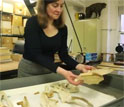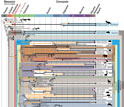News Release 13-022
Placental Mammal Diversity Blossomed After Age of Dinosaurs
Scientists build new 'tree of life' for placentals, visualize common ancestor

Artist's rendering of the hypothetical placental ancestor, a small insect-eating animal.
February 7, 2013
This material is available primarily for archival purposes. Telephone numbers or other contact information may be out of date; please see current contact information at media contacts.
Scientists have reconstructed the common ancestor of placental mammals--an extremely diverse group including animals ranging from rodents to whales to humans--using the world's largest dataset of both genetic and physical traits.
In research results published today in the journal Science, the scientists reveal that, contrary to a commonly held theory, placental mammals did not diversify into their present-day lineages until after the extinction event that eliminated non-avian dinosaurs and about 70 percent of all species on Earth, some 65 million years ago.
This finding and the visualization of the placental ancestor, a small, insect-eating animal, was made with the help of a powerful cloud-based and publicly accessible database called MorphoBank.
The Science paper is the result of a multi-year collaborative project funded by the National Science Foundation's (NSF) Assembling the Tree of Life initiative.
"Molecular clock estimates and the fossil record do not agree on the time of origin and diversification of many modern and extinct biotic groups," said H. Richard Lane, program director in NSF's Division of Earth Sciences, which co-funded the research with NSF's Division of Environmental Biology. "Data from the NSF-supported Assembling the Tree of Life initiative have been the key to these conclusions."
Analysis of this massive dataset shows that placental mammals didn't originate during the Mesozoic Era, according to the paper's lead author, Maureen O'Leary of Stony Brook University and the American Museum of Natural History (AMNH).
"Species like rodents and primates did not share the Earth with non-avian dinosaurs but arose from a common ancestor--a small, insect-eating, scampering animal--shortly after the dinosaurs' demise."
There are two major types of data for building evolutionary trees of life: phenomic data, which includes observational traits such as anatomy and behavior, and genomic data encoded by DNA.
Some researchers have argued that integration of both is necessary for robust tree-building because examining only one type of data leaves out significant information.
The evolutionary history of placental mammals, for example, has been interpreted in very different ways depending on the data analyzed.
"This discovery about the diversification of placental mammals is remarkable, highlighting that resolution of the complete tree of life requires data from both molecules and morphology," said Robb Brumfield, program director in NSF's Division of Environmental Biology. "In this case, the inclusion of fossils was a key to understanding timing and branching history deep in the tree."
One leading analysis based on genomic data alone predicted that a number of placental mammal lineages existed in the Late Cretaceous and survived the Cretaceous-Paleogene (KPg) extinction that occurred about 66 million years ago.
Other analyses place the start of placental mammals near this boundary, and still others set their origin after this event.
"There are more than 5,100 living placental species and they exhibit enormous diversity, varying greatly in size, locomotor ability and brain size," said Nancy Simmons of the AMNH and a paper co-author.
"Given this diversity, it's of great interest to know when and how this clade first began evolving and diversifying."
The new study combines genomic and phenomic data in a simultaneous analysis for a more complete picture of the tree of life.
"Despite the considerable contributions of DNA sequence data to the study of species relationships, phenomic data have a major role in the direct reconstruction of trees," said Michael Novacek, a paleontologist at the AMNH and paper co-author.
"Such data include features preserved in fossils where DNA recovery may be impossible. The mammalian record is notably enriched with well-preserved fossils, and we don't want to build trees without using the direct evidence these fossils contribute."
"Discovering the tree of life is like piecing together a crime scene," said O'Leary.
"It's a story that happened in the past that you can't repeat. Just like with a crime scene, the new tools of DNA add important information, but so do other physical clues like a body or, in the scientific realm, fossils and anatomy. Combining all the evidence produces the most informed reconstruction of a past event."
The tree of life produced in this study shows that placental mammals arose rapidly after the KPg extinction, with the original ancestor speciating 200,000-400,000 years after the event.
"This is about 36 million years later than the prediction based on purely genetic data," said Marcelo Weksler, also a co-author and a researcher at the National Museum of Brazil.
The finding also contradicts a genomics-based model called the "Cretaceous-Terrestrial Revolution" that argues that the impetus for placental mammal speciation was the fragmentation of supercontinent Gondwana during the Jurassic and Cretaceous, millions of years earlier than the KPg event.
"The new tree indicates that the fragmentation of Gondwana came well before the origin of placental mammals and is an unrelated event," said John Wible of the Carnegie Museum of Natural History and paper co-author.
As part of the study, researchers used MorphoBank, an initiative funded primarily by NSF, with additional support from Stony Brook University, the American Museum of Natural History and the National Oceanic and Atmospheric Administration to record phenomic traits for 86 placental mammal species, of which 40 were fossil species.
The resulting dataset has more than 4,500 traits detailing characteristics such as the presence or absence of wings, teeth, certain bones, type of hair cover and structures found in the brain, as well as more than 12,000 supporting images, all publicly available online.
The dataset is 10 times larger than what has previously been used for studies of mammal relationships.
Because phenomic datasets are built on physical objects like fossils that are limited in number and take time to excavate, prepare and analyze, evolutionary trees based on anatomy usually don't exceed several hundred traits.
Large-scale collection of such data for tree-building is now being called "phylophenomics."
"Cyberinfrastructure for organizing molecular biology has historically outstripped infrastructure for phenomic data, but new technologies like MorphoBank allow scientists working with phenomic data to produce larger and more complex projects, and to enrich these databases with images, references and comments," said Andrea Cirranello, paper co-author and researcher at Stony Brook University and the AMNH.
The team reconstructed the anatomy of the placental common ancestor by mapping traits onto the tree most strongly supported by the combined phenomic and genomic data and comparing the features in placental mammals with those seen in their closest relatives.
This method, known as optimization, allowed the researchers to determine what features first appeared in the common ancestor of placental mammals, and also what traits were retained unchanged from more distant ancestors.
The researchers conclude that the common ancestor had features such as a two-horned uterus, a brain with a convoluted cerebral cortex and a placenta in which the maternal blood came in close contact with the membranes surrounding the fetus, as in humans.
In addition, the study reveals that a branch of the placental mammal tree called Afrotheria, whose living members include animals -- ranging from elephants to aardvarks-- that live in Africa today, did not originate on that continent but rather in the Americas.
"Determining how these animals first made it to Africa is now an important research question, along with many others that can be addressed using MorphoBank and the phylophenomic tree produced in this study," said co-author Fernando Perini of Minas Gerais Federal University in Brazil.
Added co-author Mary Silcox, an anthropologist at the University of Toronto Scarborough, "this project exposes a way forward to collect data on other phenomic systems and other species."
-NSF-
-
See a video about the new mammal 'tree of life' discovery.
Credit and Larger Version -
The new evolutionary tree for placental mammals, combining phenomic and genomic data.
Credit and Larger Version -
This shrew-sized Cretaceous-age mammal was uncovered in the Gobi Desert.
Credit and Larger Version -
The phenomic matrix constructed in MorphoBank, including images describing traits.
Credit and Larger Version -
The research team's results are described in the Feb. 8 issue of the journal Science.
Credit and Larger Version
Media Contacts
Cheryl Dybas, NSF, (703) 292-7734, email: cdybas@nsf.gov
Kendra Snyder, AMNH, (212) 496-3419, email: ksnyder@amnh.org
The U.S. National Science Foundation propels the nation forward by advancing fundamental research in all fields of science and engineering. NSF supports research and people by providing facilities, instruments and funding to support their ingenuity and sustain the U.S. as a global leader in research and innovation. With a fiscal year 2023 budget of $9.5 billion, NSF funds reach all 50 states through grants to nearly 2,000 colleges, universities and institutions. Each year, NSF receives more than 40,000 competitive proposals and makes about 11,000 new awards. Those awards include support for cooperative research with industry, Arctic and Antarctic research and operations, and U.S. participation in international scientific efforts.
Connect with us online
NSF website: nsf.gov
NSF News: nsf.gov/news
For News Media: nsf.gov/news/newsroom
Statistics: nsf.gov/statistics/
Awards database: nsf.gov/awardsearch/
Follow us on social
Twitter: twitter.com/NSF
Facebook: facebook.com/US.NSF
Instagram: instagram.com/nsfgov





